Although the same volume balancing principle is used by all of these pedals, their approach, methodology and flexibility can vary. As such, your needs will depend on your playing style, be it versatility or simplicity and modern transparency or vintage style “warm” compression. Whatever your preference maybe, you will find a fitting compressor pedal right here in this list.
What a Guitar Compressor Pedal Does
A compressor pedal balances your sound by lowering the level of loud strings and increasing the sound of quieter strings. It does this by “squeezing” your guitar sound to make it more dynamically (volume) consistent. This uniformity is ideal for studio work to avoid sudden spikes in volume which can be problematic, and it also works in live situations for rounding off the edges of your guitar sound.
The consistency and sustain of compressor pedals can get you from balanced clean to country quack and from funky highs to tight bottom end. Another common use is for adding singing sustain to your lead lines and chords. If you are going for a bluesy solo with lots of micro-tonal and micro-volume nuances, you’re better off with minimal if not zero compression, for funky chime or country squishy sound, you need moderate compression. Finally, if you require long sustain for your shredding or biting rhythm tones, you will want to max out the compression effect.
The Best Compressor Pedals
Keeley 4-Knob Compressor
The top spot in our list goes to this versatile and impressive sounding pedal from Keeley. You’ll mostly read and hear good things about this pedal from hobbyists and professionals alike, many of which specifically praise its clean and quiet operation. At its core is quality and transparent compression that can match expensive audiophile rack-mounted rigs. The pedal’s four knob configuration gives extended control over the compression effect and it’s quite notable that all of it’s boutique quality features are enclosed in a sturdy and compact stomp box.
-
Pros: Boutique quality compression, with ultra quiet and transparent operation.
-
Cons: May not be applicable if you’re looking for vintage style warm compression.
Adrian Belew, Chalie Hunter, Pearl Jam, and John Mayer are just a few of the many artists that found the 4-Knob Keeley Compressor to their liking. And I don’t blame them because the modern super clean and transparent compression of this pedal is truly impressive. Equally impressive is the pedal’s surprising versatility thanks to its specially design set of controls that include sustain, level, attack and clipping. The Keeley 4-Knob Compressor is a bit expensive but its top notch quality is well worth the price tag. Get the latest price & reviews at Amazon.com.
MXR Dyna Comp
The MXR Dyna Comp is easily one of the most popular compressor pedals today, and it’s hard to argue with that when you see guitarists like Tim Mahoney, Joe Perry, Johnny Garcia and more using it. While it doesn’t have anything out of the ordinary to offer, its straightforward compression is implemented really well. The pedal tightens your sound and adds sustain as you increase the sensitivity setting, while the output knob lets you adjust the volume, and that’s all there is to controlling this unit.
-
Pros: Straightforward compressor that works as expected.
-
Cons: Might not have enough tone shaping options for some players.
Unlike other pedals that try to be as transparent as possible, Dyna Comp is sought after for its fatter low-end sustain and its unique vintage style tone, something which is preferred by many guitarists around the world. While other compressors tend to tame the sound, Dyna Comp actually adds a bit more oomph especially in the higher frequencies, ideal for country licks and funky riffs. It also helps that it is very affordable and looks really cool with its red sturdy stomp box case. Check out the Dyna Comp if you are looking for an affordable plug and play compressor. Get the latest price & reviews at Amazon.com.
Xotic Effects SP Compressor
With artists like Andy Timmons, Guthrie Govan, and Lee Ritenour on their roster, Xotic is a brand worth banking on. Still for a pedal that’s not from a big name manufacturer, the Xotic SP Compressor has caused quite the buzz, garnering an impressive number of consistent positive reviews. Most of them rave about its great sounding compression that’s comparable to sought after vintage Ross compressors – without the noise and hyped up price.
-
Pros: Boutique quality pedal in a compact form factor
-
Cons: Wish it was within the same price range as its competition.
Another feature that users love is the SP Compressor’s simple two-knob operation, which surprisingly allows for respectable versatility. The blend knob allows for vintage tones, that can go up to modern more transparent tones by simply turning up the blend level. Note that there’s an internal DIP switch for adjusting attack control, which allows for even more flexibility. The bottom line is you are getting a boutique quality and versatile compressor effect that’s packed in a super compact and easy to use form factor. If you’re pedalboard space is running low, or if you’re looking for a compact compressor solution, check this one out. Get the latest price & reviews at Amazon.com.
Seymour Duncan Vise Grip Compressor Pedal
Mostly known for their guitar pickups, Seymour Duncan has been steadily expanding their guitar pedal line, and I have to say that every pedal they have released so far are quite impressive. This is probably thanks to the feedback that they’re getting from their many big name artist endorsers that include Slash, Yngwie Malmsteen and Richie Sambora. The Vise Grip is part of their ever growing lineup of stompboxes, a four-knob configuration VCA-controlled compressor pedal that provides one of the cleanest compressed tones today.
-
Pros: Versatile compressor with blend control for super clean tones.
-
Cons: Can be a bit tricky to setup for inexperienced players.
The company is also known to be one of the few that actually listens to the feedback and requests of players, resulting in pedals that come with practical and nifty features, unlike others where features are merely fluff. Following the crowd favorite four knob configuration, Seymour Duncan equipped this pedal with volume, attack and sustain knobs for controlling the amount of compression and volume, while the blend knob expands the pedal’s versatility even further. My only complain is that it’s borderline pricey, but with pedals like this one, there is wisdom in the saying that you get what you pay for. Vice Grip is highly recommended if you’re looking for a modern and straightforward compressor pedal. Get the latest price & reviews at Amazon.com.
Maxon CP101 Compressor
The Maxon CP101 Compressor is much like the Dyna Comp in terms of simplicity, but instead of coloring the tone, the CP101 focuses on transparency. Since it does not alter your attack characteristics, the resulting compressed tone remains faithful to the original while keeping the dynamics stable. By not altering attack characteristics, unlike most other compressors, the resulting sound has a more natural tone with good dynamic representation.
-
Pros: Straightforward compressor pedal that provides impressive transparency.
-
Cons: Lacks tone shaping features and versatility.
Although the Maxon brand is not as well known as others, they do have a line up of impressive artists supporting their brand, including Scott Henderson, Jim Root, Marty Friedman and many more. This is a testament to the company’s impressive build and tone quality which also applies to the CP101 pedal. Being a two knob compressor pedal, it sacrifices versatility for intuitiveness – you no longer have to worry about the confusing attack or release parameters because the pedal has it set up to the most transparent parameters. While it would’ve been nice if it had more bells and whistles, the CP101 is a great plug and play compressor for guitarists who are looking for a reliable, natural sounding compression. Get the latest price & reviews at Amazon.com.
Visual Sound V2 Comp 66
From their first product, a volume pedal, Visual Sound has grown to to sit among the premiere guitar pedal builders, having established their reputation with their overdrive and distortion units. One pedal that flies under the radar but deserves mention is the Visual Sound V2 Comp 66, a versatile compressor pedal with extra features that are really practical. The most notable of these features is the built-in DIP switchable noise gate which eliminates the unwanted noise that many complain about on other units.
-
Pros: Versatile compressor pedal with built in preamp boost and gain controls.
-
Cons: Can be a bit complicated to setup because of the extra features.
Visual Sound has recently changed their name to Truetone to reflect their current product lineup, and as such will be releasing new versions of their pedals with the Truetone label. There’s no announcement yet of when the Comp 66 will get a V3 release, but even if there was, the V2 version’s versatility, quiet operation and transparent sound makes it a worthy pedal in anybody’s pedalboard. Just look at the long list of artists who have used their products, which includes Aerosmith, Hillsong United and Larry Carlton just to name a few, and it’s easy to understand why their pedals continue to be in demand. If you’re looking for a compressor pedal that handles country and blues tones well, this pedal will not disappoint. Get the latest price & reviews at Amazon.com.
Boss CS-3
The CS-3 Compression Sustainer pedal is a sturdy and utilitarian piece of gear worthy of its brand name. It gives you exactly what you need without added complications and it has enough depth and versatility for players that deal with different music genres. As expected from Boss, they did not compromise tone shaping features and packed the CS-3 with a number of extras. Thankfully, the controls are familiar which makes configuring convenient and uncomplicated, that is until you tweak away from conventional settings.
-
Pros: Reliable and sturdy, you can expect this one to outlast your other gear.
-
Cons: Great at subtle compression but requires further tweaking at higher settings.
The ideal use for this compression pedal is setting it to a lower compression level while allowing most of your attack to go through. This is where many players find great use for the CS-3, especially when paired with overdrive/distortion effects, adding natural sustain and a more punchy sound. If you’re looking for something more, you can go for the many modded versions of the CS-3 that many players are raving about. Still if you are looking for a reliable and affordable compressor box that gets the job done, just get the CS-3 and get back to making music. Get the latest price & reviews at Amazon.com.
DigiTech Main Squeeze
Digitech Main Squeeze gives you flexible compression on a budget. It provides respectable transparency in subtle settings and is capable of wild cranked up tones and sustain at higher settings. Its four knobs provide impressive flexibility for its price and with a little patience, you can dial in the right settings for your needs – ideal for working musicians who juggle various musical styles. Surprisingly, this affordable pedal does not have the choppy compression release as found on other pedals at higher settings.
-
Pros: Budget friendly compressor with in-depth controls.
-
Cons: Not as aesthetically pleasing as we’d like it to be..
The pedal lets you shape the sound a variety of ways with its Level and EQ knobs, while the Attack and Sustain lets you precisely adjust the compression settings, resulting in a pedal that can be handle a myriad of musical styles. This flexibility is quite special at the Main Squeeze price point, which is basically as affordable as it gets. Many may have skipped this pedal because it doesn’t look cool, but beyond that, this is an efficient and affordable piece of equipment that will meet your demands. If you’re budget is limited, or you’re looking to start your foray into guitar compression, this is highly recommended. Get the latest price & reviews at Amazon.com.
Electro-Harmonix Black Finger
The Black Finger is an interesting entry in this list, based on vintage high-end tube studio compressors, this stompbox is a true old school pedal. Instead of merely providing simple compression, EHX equipped this pedal with its own tube driven preamp section with gain circuitry and, as expected, tube compression. The result is a versatile analog sounding 3-in-1 pedal that includes boost, preamp and compression effects all packed inside a sturdy and nice looking chassis.
-
Pros: True vintage style warm compression thanks to its genuine tube circuitry.
-
Cons: Price tag is bit on the premium side, and the use of tubes requires maintenance.
The Electro-Harmonix Black Finger is a true optical tube compressor pedal with two 12ax7 tubes on an optical circuit. One tube handles the compression stage while the other tube works on the gain stage. Both tubes work together to provide you with a classic fat compressed sound that maintains good tube dynamics. This effect is ideal if you are aiming for biting and analog tones. Its tube tone comes with maintenance work and careful handling since it uses actual tubes. Note that the Black Finger is not limited to just guitars, because even bass players dig this stompbox. Get the latest price & reviews at Amazon.com.
Empress Effects Compressor Pedal
With pro guitarists like Adrian Belew, Paul Gilbert, Ethan Roberts, James Valentine and more endorsing their gear, Empress branded pedals are steadily growing in reputation. The Empress Compressor is one of them, well received for its transparency and versatility. Instead of going for the oversimplified setup found on other units, the Empress Effects Compressor comes with more controls for studio level tone shaping precision.
-
Pros: Studio quality, transparent and versatile, ideal for modern musicians.
-
Cons: Will require you to invest a bit more than the typical budget for compressor pedals.
All essential controls found on studio compressors are carried over into this pedal, with each parameter easily accessible via the front fascia knobs and switches. This allows for a wide variety of compression styles from vintage to modern transparent, and thanks to the mix knob, you can go further into subtle or excessive compression territories. Like all Empress Effects, this pedal features an all-analog signal path to ensure that the dynamics of your playing can go through unabated. There’s even a set of LEDs that let you visually monitor what the compressor is doing, a nifty feature that gives you even more tone sculpting precision. If budget and space is not an issue, and you’re looking for versatility, then we recommend the Empress Effects Compressor. Get the latest price & reviews at Amazon.com.
Final Thoughts
When it comes to compressor pedals, less is more strictly applies – especially for inexperienced users. The best approach is to subtly add compression and slowly work your way up until you find the attack, sustain and compression settings that you prefer. Please feel free to share your thoughts and any experiences with your favorite or least favorite compressor pedals in the comments below.
Related Articles:
Our list of the best Phaser Pedals

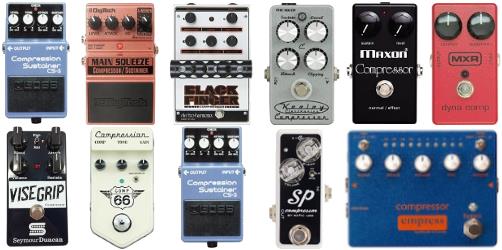
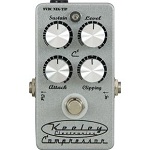
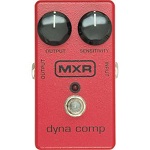
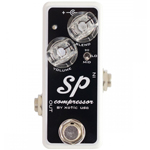
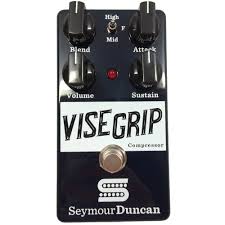
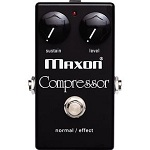
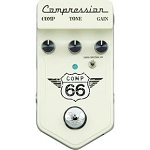
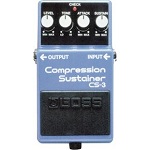
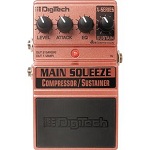
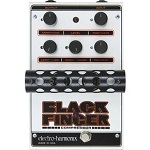
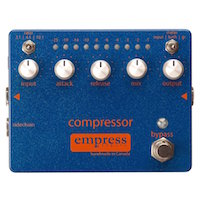
My fav is the dyna comp but I find the super comp w an added attack control makes a dyna comp that much better.